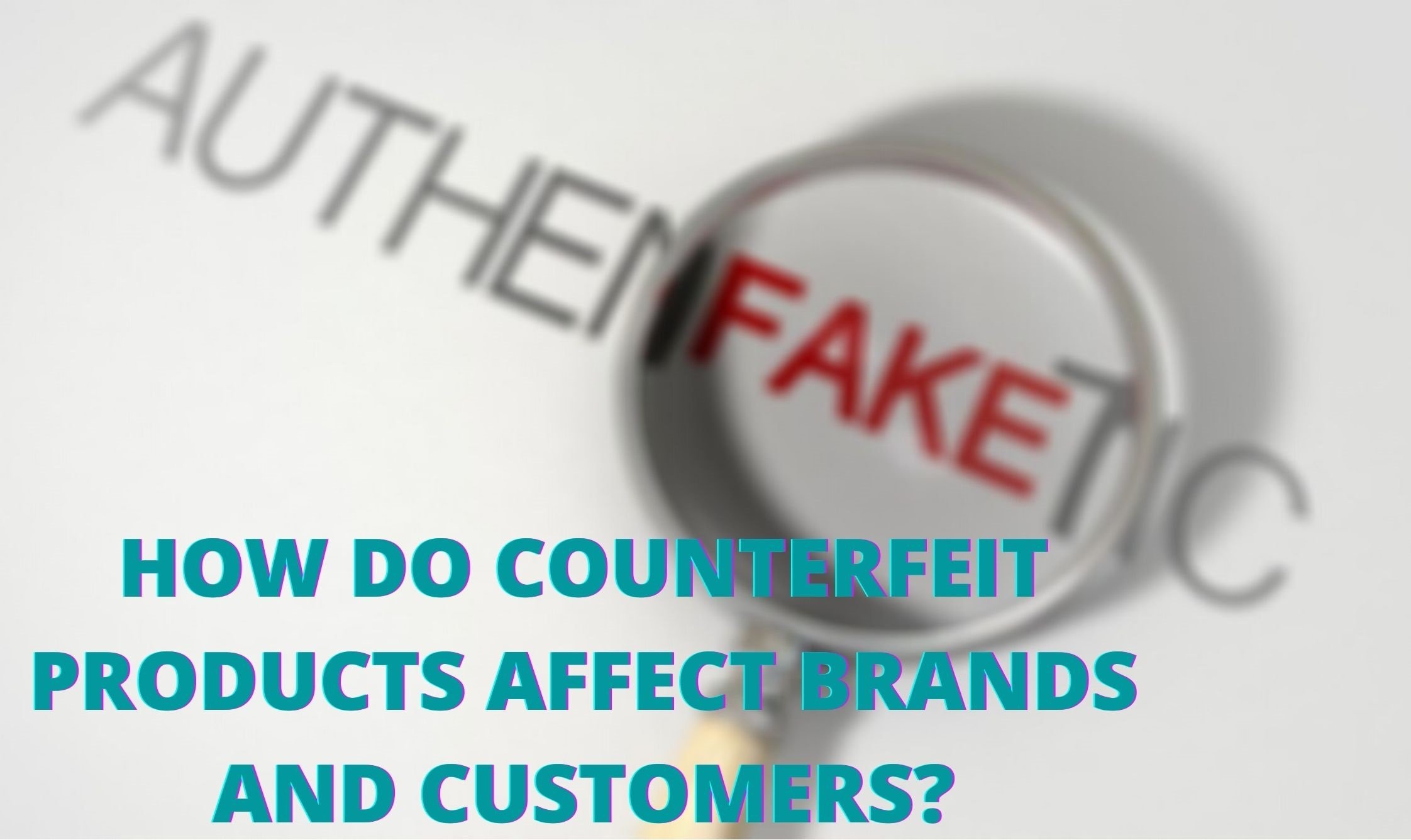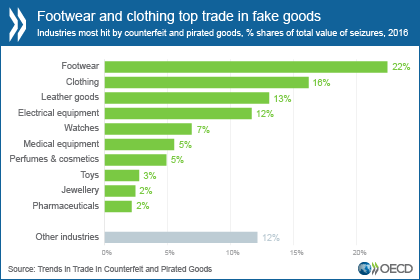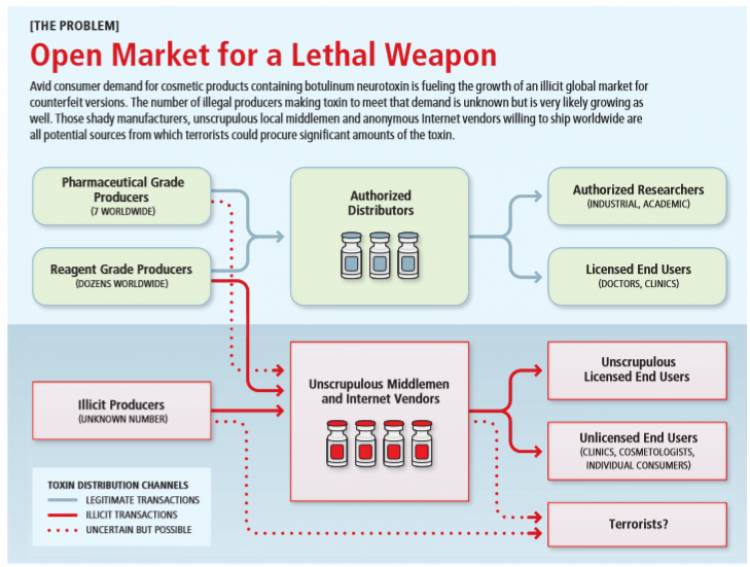HOW DO COUNTERFEIT PRODUCTS AFFECT BRANDS AND CUSTOMERS?
In today’s era of globalization and liberalization, businesses are growing at an accelerating pace and are becoming the most significant element in the economy which in turn determines the growth and development of various other sectors and industries of the economy like Export and import, tax, employment, development etc. Every business is run by ideas, dynamism, quality and management which are acquired with years of knowledge and experience. CUSTOMER is another significant element of any industry which helps the business sustain in the global market, whose choice of product solely depends upon the reputation of the business.

INTRODUCTION
In today’s era of globalization and liberalization, businesses are growing at an accelerating pace and are becoming the most significant element in the economy which in turn determines the growth and development of various other sectors and industries of the economy like Export and import, tax, employment, development etc. Every business is run by ideas, dynamism, quality, and management which are acquired with years of knowledge and experience. CUSTOMER is another significant element of any industry that helps the business sustain in the global market, whose choice of product solely depends upon the reputation of the business.
The reputation and global image of the business or the product is made through various factors like:-
- Knowledge about the brand
- Quality of the product
- Awareness about its sales and marketing
- Advertisement expenditure
- Market research
FEATURES OF A BRAND NAME
- The dynamic nature of the business helps the customer visualize the brand name and recognize its value in their life. A brand name is something which can be made overnight, but its value can only be understood with the year passing by.
- A brand name yields the company a competitive advantage over the other minimalistic products available in the market and also maximizes revenue.[1]
- The brand name is an outcome of the intellect of the owner demonstrating a good relationship with the customer by promoting quality products under a particular name which is legally known as INTELLECTUAL PROPERTY.
To know more about How to chose the best brand name for your start-up/company, watch the video below -
INTELLECTUAL PROPERTY AND BRANDING
Intellectual Property Rights is a branch of law where protection is granted to the owner of IP, holding exclusive right over any creation and innovation. Intellectual property is not just the right of the owner over their work or innovation or creativity, it also reflects massive investment made by the business over a long period to gain the trust of the customer. A considerable amount of time and consistency in the quality of the product is maintained by the business to overshadow the rival brands in its line of the market. With the rise in demand for branded products and the removal of international boundaries on imports, the local businesses have been benefitting by introducing counterfeited products into the market.
A report published by the Organization For Economic Co-Operation And Development[2] And European Union’s Intellectual Property Office observes that the introduction of counterfeited products into the market has caused a huge loss to not only the business but also to the economy. The trendy counterfeited products seize the market of the original product with an infringement to its intellectual property rights. With this, the local products take over the market, gain profit, supply unqualified products at the cost of the company and the economy. When the customer shifts from the original brand to a local counterfeited product, the company suffers a huge capital loss. This tarnishes the reputation of the brand due to the introduction of low-quality products.
Fig 1.Product categories most subject to counterfeiting and piracy, 2013 and 2016.

The above chart shows the impact of counterfeited products on food, clothing, pharmaceuticals, Jewellery etc which ranges from 2% to 22%.
The counterfeited products are causing great damage to the trademark and copyright of the original owner whose businesses are solely dependent upon the Distinctiveness of the Brand. An informed customer is likely to make a better choice by understanding the originality of the product whereas; confusion can be created in the minds of negligent customers.
This calls for international organizations like European Union, General Agreement on Tariff and Trade[3], North American Free Trade Agreement and various other multinational trade agreements to prioritize the protection of the intellectual property rights under the realm of International Trade by discouraging the use of counterfeited products. The need was felt to introduce stringent rules pertaining to use, manufacture, retail and the supply of these counterfeited goods and giving exclusive rights to the owner for commercial exploitation of their innovation.
EFFECTS OF COUNTERFEIT PRODUCTS ON THE BRAND
- A company always wins over its rival by planning, organizing, directing and controlling where it estimates the returns expected from the sale of a particular product/goods. But, when the estimated revenue is hampered by the counterfeited product, even the giant multinationals can incur great losses over its sales.
- Due to the introduction of the counterfeited product into the market, an enormous amount of money invested in Research and Development gets wasted and the whole process becomes defected.
- A decline in the sale can lead to a loss of employment in the sector. Thereby, affecting the jobs of the public at large.
- With the loss of the market for the original product, the business suffers a sharp decline in the goodwill of the company.
- The taxes such as VAT, Excise Duty etc levied on these products are not received by the government and this hampers the government’s revenue.
EFFECTS OF COUNTERFEIT PRODUCTS ON THE CUSTOMER
- The counterfeited product may either match the quality of the original product or either manufacture low-quality product resulting in misleading the loyal customer of the brand.
- With the advent of the online platform for shopping and retailing, the low quality/ counterfeited products are easily made available to the customers.
- These local brands are funded by local manufacturers whose traces cannot be monitored in a complex economy and unorganized chain of the market.
- While the majority argument is based on the quality of the counterfeited products, some cases have been reported to have caused grievous health risks to the customers.
CASE STUDIES ON COUNTERFEIT PRODUCTS
- Botulinum (BoNT) [4], a type of drug found in cosmetic products was rarely licensed to a cosmetic company due to its toxicity and chances of causing allergy if used illicitly. The spread of counterfeited BoNT caused the hospitalization of four people and a near-death situation with several others. And a criminal action was brought against the original company.
The investigation was done to trace the unauthorized manufacturing of counterfeit BoNT by collecting samples from various countries and it was found out that the mysterious sale of counterfeit BoNT Drug originates from mainly in Asian countries. The illicit sellers were altering with the composition of the drug. This was observed in the chain of supply that unlicensed sellers and local middleman, and even terrorist activities have caused a diversion towards illegal selling of these toxins.

(Source: https://www.scientificamerican.com/article/fake-botox-real-threat/ )
- In a recent case of Apple Inc. v. Mobile Star LLC[5] counterfeit products, Apple conducted a sting operation against the biggest online retailing platform- Amazon. Apple ordered more than 100 products which were portrayed as original product manufacture by Apple Inc. After the investigation was done it was found out that more than 90% of the products sold on Amazon by various retailers are counterfeited and of inferior quality.[6] Apple filed an infringement suit against the retailer named Mobile Star for the breach of trademark. It asked the Federal court to pass ‘John Doe’ order against the respondent with an award up to $2 million per counterfeit mark.
OBSERVATION AND CONCLUSION
- It is furthermore observed that the conflict arising with respect to the retail of the counterfeiting product is due to the economical disparities between different nations. The ‘innovators’ and creators, in a broader sense, are belonging to the developed nations, whereas, the ‘imitators’ and counterfeiters are belonging to the developing nation. This may be a controversial observation to be raised but it is also the most relevant issue building the nexus between the socio-economic condition of the nations and the prevailing laws.
- To support this argument it is further stated that the regulatory frameworks and protection laws in a developed nation is more stringent and has encompassed almost all the realms of the subject matter. Whereas, the framework of the developing nations remained inadequate in implementing the provision.
- Another reason would be the demand for cheaper products in developing nations due to poverty and low income. A customer will tend to shift to the low-quality product in pursuit of Cheap Price Tags, while the customers belonging to the developing nations earn a better income and can afford the high-quality product at its original price.
- The imitation of the original product can be easily executed in the course of licensing. It is analyzed by various judgments that the LICENSEE of the original product provides an unauthorized license to the independent distributors to produce local products. This activity is based on the nation where the population is poor and unskilled.
Fig 2. Report on the global seizure of IP-infringing products
(Source: https://www.oecd-ilibrary.org[7])
Fig.2 Shows report of the ‘Organisation for Economic Co-operation and Development (OECD) that from 2013 to 2016, the share of global custom seizure in counterfeited products is found largely in the nations like China, Hong Kong, Turkey, Singapore, Germany, Thailand and India. Out of the above 12 economies, 10 economies are belonging to Developed nations. This observation is made to understand that the highest counterfeited products are found in the largest economies of the world.
It is a well-known fact that the economies like the United States, France United Kingdom, Japan, Germany and Sweden top the list of highest registered Intellectual Property Mark. And the report submitted below admits the same contention.
Fig 3. Top economies of origin of right holders whose IP rights are infringed, 2014-16 report.[8]
These statistics show that the highest numbers of counterfeited products were infringing the original work of the IP holders located in the UK, US, Sweden, Italy, Germany, France, Japan Switzerland, etc. These countries suffer greater damage in terms of IP infringement. This includes the list of those countries which are technologically advanced and economically wealthy.
After analyzing the above findings from figure 1 and figure 2, it can be concluded that the nations like China and Hong Kong are also included in the list of economies that are impacted by global counterfeiting but in contrast, China, Hong Kong, and India tops the list of custom seizure of the counterfeited products. This indicates the threat to the efforts of Chinese companies that are using intellectual property in their business.
The TRIPS Agreement provides for remedies and procedures for counterfeiting products. It inevitably criminalized the counterfeiting of products with prescribed procedure to be followed and remedies granted to the holder of IP.[9] The criminal remedies can extend to seizure, forfeiture, destruction, and compensation for the infringed IP or counterfeited product. The counterfeited products may work as a blessing for the people who wish to avail of branded products at lower prices but in reality, it’s a camouflage surrounding dreadful consequences. Therefore it’s the duty of the businesses as well as the people of the country to refrain from using the counterfeited products and abide by the regulatory framework.
BY: SOUMYA SONI
[1] Casson, M., 2012. Brand Protection and the Globalization of British Business. The Business History Review, The President and Fellows of Harvard College, [online] 86(2). Available at: <https://www.jstor.org/stable/23239500> [Accessed 7 January 2021].
[2] OECD.org. 2019. Trade In Fake Goods Is Now 3.3% Of World Trade And Rising. [online] Available at: <https://www.oecd.org/newsroom/trade-in-fake-goods-is-now-33-of-world-trade-and-rising.htm> [Accessed 6 January 2021].
[3] Docs.wto.org. 1979. Agreement on Measures to Discourage the Importation of Counterfeit Goods. [online] Available at: <https://docs.wto.org/gattdocs/q/GG/L4999/4817.PDF> [Accessed 7 January 2021].
[4] Colema, K. and A. Zilinska, R., 2010. FAKE BOTOX, REAL THREAT. Scientific American, a division of Nature America, Inc., [online] 302(6), pp.84-89. Available at: <https://www.jstor.org/stable/10.2307/26002070> [Accessed 8 January 2021].
[5] Case No. 16-cv-06001-WHO (N.D. Cal. Sep. 12, 2017)
[6] Hall, G., 2016. Ninety percent of 'genuine' Apple chargers on Amazon are fake. Silicon Valley Business Journal, [online] Available at: <https://www.bizjournals.com/sanjose/news/2016/10/20/ninety-percent-of-genuine-apple-chargers-on-amazon.html> [Accessed 8 January 2021].
[7] Available at: https://www.oecd-ilibrary.org/sites/98ff165d-en/index.html?itemId=/content/component/98ff165d-en#:~:text=Provenance%20economies,-Virtually%20any%20economy&text=In%20other%20words%2C%20some%20economies,ranking%20(see%20Figure%203.1).
[9] Art. 16 TRIPS Agreement












